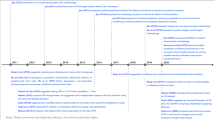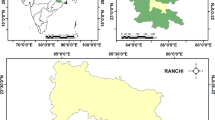Abstract
The spatiotemporal variability of rainfall, particularly in the context of climate change, has been imperative for examining the crop** patterns, farming sustainable crop production, and food security in rainfed areas. To that end, trend analysis was done to study the change in rainfall patterns in the mid-hills of Himachal Pradesh. The study investigated the historical rainfall data from 1971 to 2020 on a monthly, annual, seasonal, and decadal basis by using the variability analysis methods, viz., standard deviation (SD), coefficient of variance (CV), and transformed annual precipitation departure (Z). The trend analysis was also done by Mann–Kendall (MK) and Sen’s slope estimator (SSE) test and linear regression model. The annual rainfall in the region was 1115.1 mm, which showed a decreasing trend (Z = − 0.79 mm/year). Based on the linear regression model, the decrease in annual rainfall was about − 2.28 mm/year. The monthly and seasonal variability of rainfall exhibited a sensitivity to change. The months of January, April, July, and September showed an increasing trend, whereas the rest of the other months showed a decreasing trend. The seasonal rainfall (summer, monsoon, and post-monsoon) showed a decreasing trend, whereas the winter season depicted an increasing trend. During the entire study period, 1988 recorded as the wettest year, with highest annual rainfall of about 2205.0 mm and monsoon rainfall of about 1653.0 mm. The highest annual (2205.0 mm) and monsoon (1653.0 mm) rainfall was recorded in the year 1988. The decadal analysis of the rainfall on an annual basis revealed a decrease in rainfall during the periods 1971–1980, 2001–2010, and 2011–2020 as compared to 1981–1990 and 1991–2000. The rainfall over the study region confirms the strength of the change in trend. Thus, the erratic rainfall pattern makes the crop** calendar shorter and affects the agricultural productivity.





Similar content being viewed by others
Data availability
Not applicable.
Code availability
Not applicable.
References
Allan RP, Soden BJ (2008) Atmospheric warming and the amplification of precipitation extremes. Science 12:1481–1484. https://doi.org/10.1126/science
Apata TG (2010) Effects of global climate change on Nigerian agriculture: an empirical analysis. J Appl Stat 2:45–60
Attri S D, Tyagi A (2010) Climatic profile of India. Environment Monitoring and Research Centre, India Meteorological Department, Lodi Road, New Delhi pp 122.
Connors S, Piddock R, Alle M et al (2019) Frequently asked questions Intergovernmental Panel on Climate Change (IPCC). (www.ipcc.ch/site/assets/uploads/sites/2/2019/05/SR15_FAQ_Low_Res.pdf).
Dash S, Jenamani R, Kalsi S, Panda S (2007) Some evidence of climate change in twentieth-century India. Clim Change 85:299–321
Government of India (2021) Statement on climate of India during 2020. Press release, 4 January. https://reliefweb.int/sites/reliefweb.int/files/resources/Statement_of_Climate_of_India-2020.pdf. Accessed 4 January 2021
Jaswal AK, Bhan SC, Karandikar AS, Gujar MK (2015) Seasonal and annual rainfall trends in Himachal Pradesh during 1951–2005. Mausam 66:247–264
Kahn M E, Mohaddes K, Ng R N, Pesaran M H, Raissi M, Yang J C (2019) Long-term macroeconomic effects of climate change: a cross-country analysis. National Bureau of Economic Res. pp 1–59. www.imf.org/en/Publications/WP/Issues/2019/10/11/Long-Term-Macroeconomic-Effects-of-Climate-Change-A-Cross-Country-Analysis-48691. Accessed 11 October 2019
Kaur N, Kaur P (2019) Maize yield projections under different climate change scenarios in different districts of Punjab. J Agrometeorol 21:154–158
Kaur N, Yousuf A, Singh MJ (2021) Long term rainfall variability and trend analysis in lower Shivaliks of Punjab. India Mausam 72:571–582
Kendall M G (1975) Rank correlation methods”, 4th ed. Charles Griffin, London. Sen, P. K., 1968 Estimates of the regression coefficient based on Kendall’s Tau. J American Stat Ass. 63: 1397–1412
Krishan R, Ayush C, Bhaskar N, **ale S, Khare D (2018) Long term rainfall data analysis over Eastern Ganga canal command area. Ind J Soil Cons 45:338–347
Krishnan R, Sanjay J, Gnanaseelan C, Mujumdar M, Kulkarni A, Chakraborty, S (2020) Assessment of climate change over the Indian region. A report of the Ministry of Earth Sciences (MoES), Government of India. Singapore: Springer.1–243.
Kumar V, Jain SK, Singh Y (2010) Analysis of long term rainfall trends in India. Hydro Sci J 55:484–496
Power K, Axelsson J, Wangdi N, Zhang Q (2021) Regional and local impacts of the ENSO and IOD events of 2015 and 2016 on the Indian Summer Monsoon—a Bhutan case study. Atmosphere 12:954. https://doi.org/10.3390/atmos12080954
Rathod IM, Aruchamy S (2010) Spatial analysis of rainfall variation in Coimbatore district Tamil Nadu using GIS. Int J Geo and Geosci 1:106–118
SCCAP (2012) State strategy and action plan on climate change, Department of Environment Science and Technology, Government of Himachal Pradesh, Shimla.
Sen PK (1968) Estimates of the regression coefficient based on Kendall’s tau. J American Stat Ass 63:1379–1389
USAID – United States Agency for International Development (2017) Climate risk profile: India. Washington DC: USAID (www.climatelinks.org/resources/climate-risk-profile-india).
Vennila G (2007) Rainfall variation analysis of vattamalaikarai sub-basin Tamil Nadu. J Appl Hydro 20:50
Acknowledgements
The authors wish to thank the GKMS project and the India Meteorological Department (IMD), for providing the facilities to record the rainfall data. The authors are also thankful to the Department of Environmental Science, UHF, Nauni, and Agromet Observer who have made contributions over the years to record and collect the rainfall data presented in this research paper.
Funding
This work was funded through GKMS project, and the grant was supported by India Meteorological Department, Ministry of Earth Sciences, New Delhi, India.
Author information
Authors and Affiliations
Contributions
PM, idea generation, data analysis, data processing, and writing/reviewing; MSJ, idea generation and reviewing; SKB, idea generation and reviewing; and SP, availability of data and reviewing.
Corresponding author
Ethics declarations
Ethics approval
Not applicable.
Consent to participate
Not applicable.
Consent for publication
Not applicable.
Conflict of interest
The authors declare no competing interests.
Additional information
Responsible Editor: Philippe Garrigues
Publisher's note
Springer Nature remains neutral with regard to jurisdictional claims in published maps and institutional affiliations.
Rights and permissions
About this article
Cite this article
Mehta, P., Jangra, M.S., Bhardwaj, S.K. et al. Variability and time series trend analysis of rainfall in the mid-hill sub humid zone: a case study of Nauni. Environ Sci Pollut Res 29, 80466–80476 (2022). https://doi.org/10.1007/s11356-022-21507-0
Received:
Accepted:
Published:
Issue Date:
DOI: https://doi.org/10.1007/s11356-022-21507-0




